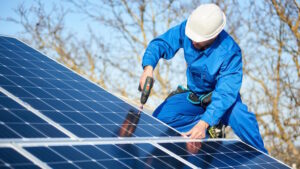As the world moves towards more sustainable and eco-friendly energy sources, solar panel installations have become increasingly popular among homeowners and businesses alike. Solar power harnesses the sun’s energy to generate clean electricity, reducing your reliance on fossil fuels and potentially lowering your energy bills. This comprehensive guide will walk you through the process of solar panel installation, covering essential aspects such as what solar panels are, solar panel systems, and solar battery storage.
What are Solar Panels?
Solar panels, also known as photovoltaic (PV) panels, are devices that convert sunlight into electricity. They consist of several solar cells made from semiconductor materials, typically silicon, which absorb photons from sunlight and generate an electric current through a process called the photovoltaic effect. Solar panels have become increasingly efficient and affordable over the years, making them a viable option for clean and renewable energy generation.
What is a Solar Panel System?
A solar panel system is a complete setup that converts sunlight into electricity for use in your home or business. The system consists of several key components, including:
- Solar Panels: These panels absorb sunlight and convert it into direct current (DC) electricity.
- Inverter: The inverter is responsible for converting the DC electricity generated by the solar panels into alternating current (AC) electricity, which is compatible with your home’s electrical system.
- Mounting System: The mounting system securely fastens the solar panels to your roof or other structures, ensuring stability and optimal positioning to capture sunlight.
- Electrical Components: These components, including wiring and switches, connect the solar panels to your home’s electrical system and the utility grid.
Solar Battery Storage
Solar battery storage is an optional but valuable addition to your solar panel system. Solar battery stores excess electricity generated by your solar panels, allowing you to use them when the sun isn’t shining, such as during evenings or cloudy days. By incorporating a solar battery storage system, you can maximize the benefits of your solar panel installation, increase your energy independence, and potentially reduce your reliance on grid-supplied electricity. – If you are looking for the best Solar Panels Marbella has to offer, then look no further!
Factors to Consider Before Solar Panel Installation
- Roof Condition: Ensure your roof is in good condition and can support the weight of solar panels. If your roof needs repair or replacement, it’s best to address those issues before installation.
- Sunlight Exposure: Solar panels require adequate sunlight exposure to generate electricity efficiently. Make sure your roof receives unobstructed sunlight for most of the day, without significant shading from trees, buildings, or other obstacles.
- Local Permits and Regulations: Familiarize yourself with local permits and regulations related to solar panel installations. Some jurisdictions may have specific requirements or incentives for installing solar panels.
- System Size and Energy Needs: Determine the appropriate system size based on your energy consumption and available roof space. A professional solar installer can help you evaluate your energy needs and recommend the right system size.
What are the benefits of installing a solar panel system?
Installing a solar panel system comes with a multitude of benefits that make it an attractive investment for homeowners and businesses alike. Some of the key advantages include:
- Environmentally Friendly: Solar energy is a clean, renewable source of power that does not produce harmful emissions or contribute to climate change, making it an environmentally responsible choice for energy generation.
- Reduced Energy Bills: By generating your own electricity through solar panels, you can significantly reduce your reliance on grid-supplied energy, potentially leading to lower monthly utility bills.
- Energy Independence: Solar panel systems can increase your energy independence, allowing you to rely less on utility companies and their fluctuating energy prices.
- Low Maintenance: Solar panels require minimal maintenance, with only occasional cleaning necessary to ensure optimal performance. Additionally, most solar panel systems come with long-term warranties,
 providing peace of mind for homeowners.
providing peace of mind for homeowners. - Increased Property Value: A solar panel installation can increase the value of your property, making it more attractive to potential buyers who appreciate the benefits of clean energy and lower utility bills.
- Tax Incentives and Rebates: Many governments and utility companies offer financial incentives, such as tax credits, rebates, or grants, to encourage the adoption of solar energy, making the initial investment more affordable.
- Scalability: Solar panel systems are easily scalable, allowing you to start with a smaller system and expand it over time as your energy needs grow or your budget allows.
- Energy Storage: By incorporating solar battery storage into your system, you can store excess energy generated during the day for use at night or during periods of low sunlight, further increasing your energy independence and self-sufficiency.
How are solar panels made?
Solar panels are made through a series of intricate processes that involve the transformation of raw materials, primarily silicon, into functional photovoltaic (PV) cells that can convert sunlight into electricity. The manufacturing process can be broken down into several key steps:
Silicon Processing: The production of solar panels starts with raw silicon, which is derived from silica, a compound found in quartz sand. The silicon is purified through a series of chemical and metallurgical processes to obtain high-purity polysilicon.
Ingot and Wafer Formation: The purified polysilicon is then melted in a furnace and formed into a cylindrical structure called an ingot. The ingot is then sliced into thin wafers using a wire saw or other cutting techniques. These thin silicon wafers serve as the base for solar cells.
Cell Processing: The silicon wafers undergo a series of treatments and processes to create photovoltaic cells. These processes include:
- Texturing: The wafer’s surface is etched or textured to reduce reflectivity and increase its ability to absorb sunlight.
- Doping: The wafers are treated with chemicals, such as phosphorus or boron, to create a positive-negative (P-N) junction, which is essential for generating an electric current when sunlight hits the cell.
- Anti-Reflective Coating: An anti-reflective coating is applied to the surface of the wafer to further reduce light reflection and increase light absorption.
- Metal Contacts: Metal contacts are added to the front and back of the cell to allow the flow of electrons, generating an electric current.
Cell Interconnection: Individual solar cells are interconnected using metal ribbons or wires to form a solar panel. The interconnection process creates a series-parallel configuration that determines the panel’s overall voltage and current output.
Encapsulation and Lamination: To protect the interconnected solar cells from environmental factors such as moisture, dust, and temperature fluctuations, they are encapsulated using a transparent protective material, typically ethylene-vinyl acetate (EVA). The encapsulated cells are then sandwiched between a glass cover on the front and a back sheet material, usually made of polymer, on the rear. The entire assembly is laminated together to create a single, durable solar panel.
Frame and Junction Box: A durable aluminium frame is added to the solar panel for structural support and ease of installation. A junction box is attached to the back of the panel, housing the electrical connections, and providing a point of connection for the panel’s wiring to the rest of the solar system.
Testing and Quality Control: Finally, the finished solar panels are tested for performance, efficiency, and safety to ensure they meet industry standards and quality specifications. Once they pass all tests, they are packaged and shipped for installation.
The entire solar panel manufacturing process is constantly being refined and improved to increase efficiency, reduce production costs, and minimize the environmental impact of panel production.
Hiring a Professional Solar Installer
While it may be tempting to attempt a DIY solar panel installation, hiring a professional solar installer is highly recommended. A professional installer will ensure your system is designed and installed correctly, maximizing its efficiency and lifespan. They will also handle the necessary permits and inspections and ensure that your solar panel system complies with local regulations.
Solar panel installation can be a smart investment for homeowners and businesses seeking a sustainable, eco-friendly energy source. By understanding the different components of a solar panel system and the factors to consider before installation, you can make an informed decision and take the first step towards a greener and more energy-independent future.

